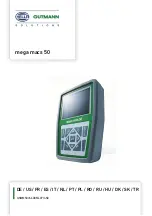
Maintenance
Maintenance
Maintenance Task
Task
Task
Daily
Daily
Daily
Weekly
Weekly
Weekly
Perform a pump stall test. Follow the
Pump Stall Test Procedure, page 60
Perform task any time fluid is seen at the weep holes on the isolation fluid pump, or
any time the pump is serviced.
�
Check the bleed resistor. Follow the steps in
Check the Bleed Resistor, page 69
.
Prepare
Prepare
Prepare the
the
the System
System
System for
for
for Service
Service
Service
1.
Discharge the voltage in the system. Follow
the
Fluid Voltage Discharge and Grounding
2.
Flush the system. See
(Systems without Color Change), page 31
or
Flush the System (Color Change Enabled
Systems), page 32
.
3.
Relieve the pressure in the system. Follow the
Pressure Relief Procedure, page 30
4.
Press the Stop button
on the control
interface and unplug the power cord (Y).
5.
Service the component or perform the
maintenance task.
Check
Check
Check for
for
for Fluid
Fluid
Fluid Leaks
Leaks
Leaks
Check for fluid leaks daily.
NOTICE
NOTICE
NOTICE
Any fluid leaking or pooling inside the system can
cause low system voltage or arcing that damages
system components. Clean and dry leaks.
1.
Prepare the isolation system for service. Follow
the steps in
Prepare the Isolation System for
2.
Use a flat blade screwdriver to open the isolation
cabinet door.
3.
Slide the electrostatic shield (12) up to remove.
4.
To remove the isolation valve cover (99), loosen
the top and bottom screws (99a).
5.
Inspect the following locations in the isolation
cabinet:
• Connection to the fluid outlet hose (E).
• Inlet valve (F).
• Isolation valve (G).
• Wipe any build-up off of the isolation valve
components (211, 222).
NOTICE
NOTICE
NOTICE
Fluid build-up on the isolation valve
components can cause seal damage that
results in fluid leaks.
• Check the level of the wash fluid. The level
should be above the minimum line marked on
the wash fluid bottle. Leaking isolation valve
seals can cause the wash fluid level to change.
• Connections to the isolation fluid pump (K).
• Fluid weep hole (WH). If the fluid seal has
broken, fluid eventually fills up behind the
piston and causes fluid to leak out of the weep
hole on the left.
Figure 30 Inspect for Fluid Leaks
3A8493A
67
















































